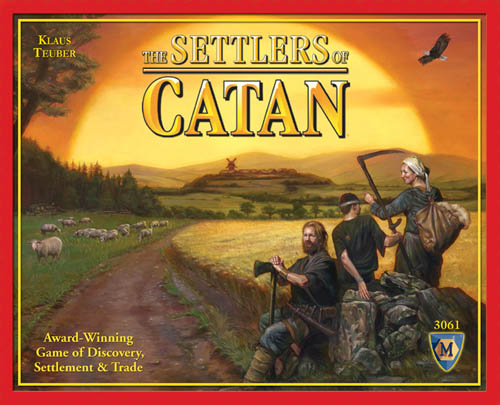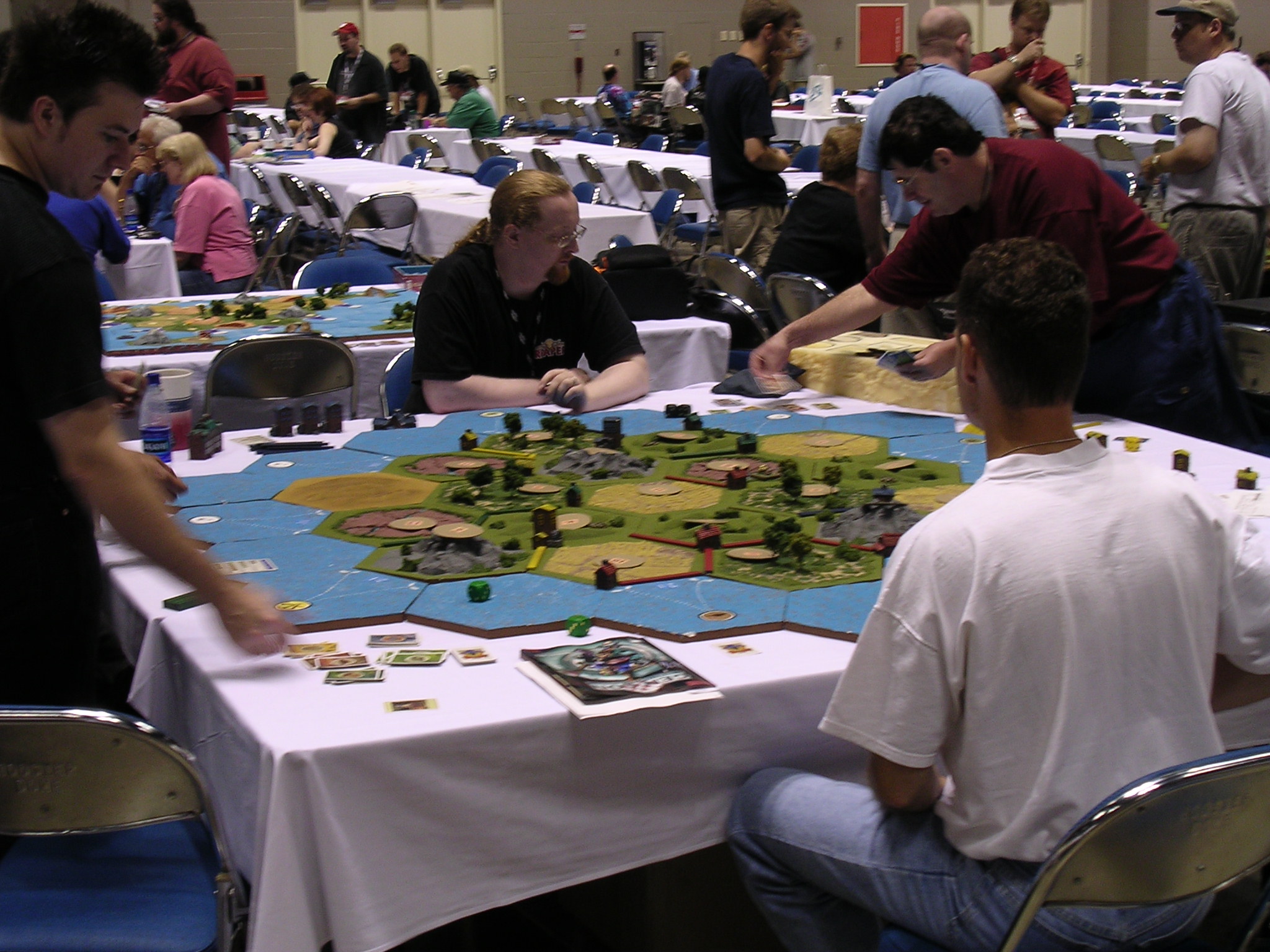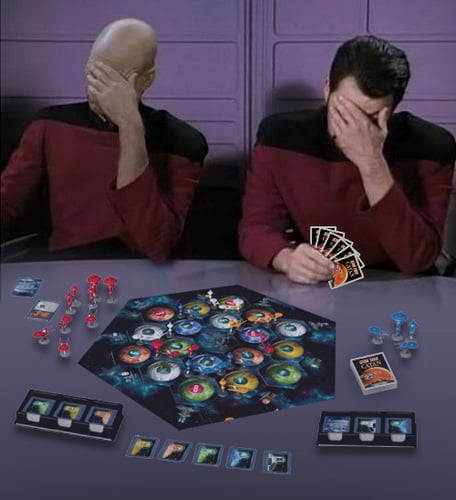I've changed the rules from six steps to three. This has many advantages, including speeding
up the gameplay considerably.
Now, instead of being able to Frenzy, Crusade, and Reinforce
every round, in a particular order, you must pick one to do.
After making the rule change, I realized just how many
Rogations and Locations have functions that require those six steps to exist,
so I had to reword many of them to make more sense with the new rules.
 |
| And in some cases, I completely changed the text altogether. |
Rogations can be performed at any time, between actions
(meaning if a person is engaged in a Crusade and is busy figuring out who won,
someone can't play a Rogation in the middle of that).
 |
| Some still carry the same gist. |
Because the rules have such a major change to them, I
thought it'd be important to post them again (also included are examples of the
types of cards discussed):
Vortex
A card game for 2-4 Players.
Decks: 24 Blue, Green, Red, and Yellow cards, 48 Locations, 48 Rogations, and 50 Frenzies.
Goal: Convert more Devotees into True Converts and/or Fearful than your opponent(s). You score one point for each Convert you have at the end of the game. If you are the Red player, you also get an additional 1/2 point for every Devotee in the Vortex of another color.
Pile Layout: Each Player has a face-down pile called the Draw Pile. Each Player also has a face-up pile called the Discard Pile, which they shuffle and place face-down to create a new Draw Pile when their Draw Pile runs out. Each Player also has a face-up pile called the Fearful Pile.
The Location cards also have piles of their own. Unused Location cards are placed face-down in one pile, and as each is revealed it gets discarded in a separate face-up pile.
There is also a pile for killed Devotees/Zealots with attached Frenzies, and used Rogations. This pile is called the Vortex.
Game Setup: Shuffle the Location cards and place them facedown. This is the Location Deck. Each player is given all 24 cards of one Devotee color, then is randomly dealt 12 Frenzies and 12 Rogations. Put the unused Color cards, Frenzies and Rogations away. Each Player shuffles their deck, places it facedown, then draws seven cards from their deck.
SUGGESTION FOR BEGINNERS: Ignore the rules on Location Cards.
SUGGESTION FOR BEGINNERS: Do not use Rogation Cards.
SUGGESTION FOR BEGINNERS: If your game is 2 or 3 players, leave out Red.
Play begins. Each round, there are 3 phases:
1.) Location phase.
2.) Action phase.
3.) Refill phase.
Phase 1. LOCATION PHASE
Flip over a new Location card. The Location card tells the players the turn order for the Action Phase, as well as supplies any additional rules that are in play during that round.
 |
| Location example. |
If the last Location card is drawn, the game ends after this round is complete.
Phase 2. ACTION PHASE
During the Action Phase, Players perform actions according to the turn order indicated on the Location card. During the Action phase, a Player may perform one of three actions:
a.) Reinforce
b.) Frenzy
c.) Crusade
Action a.) REINFORCE
The Player may place 1 or 2 Devotees face-up onto the Field of Play. Players have a maximum of 4 Devotees/Zealots in Play at one time, so if a Player is maxed out, they cannot Reinforce. If they wish, the Player may take 1 or 2 Devotees/Zealots out of play, and put into their discard pile, with any attached Frenzies. Players may ONLY take cards out of play if they are maxed out.
 |
| Devotee examples. |
If there are no Devotees/Zealots in a Player's Field of Play during their Action Phase, the Player MUST Reinforce, and may not perform another action (this also means that at the beginning of the game, all players MUST Reinforce on their first turn, as they have no cards in play). If the Player is forced to Reinforce but does not have the cards in hand to do so, the player must discard their hand and draw seven new cards. Repeat if necessary. If the Player goes through their entire deck unable to Reinforce, the Player cannot play any other actions until they are able to Reinforce again. (The player may still play Rogations.)
Action b.) FRENZY
The Player may place 1 Frenzy card face-down near 1 of their Devotees in play, OR replace an unrevealed Frenzy, OR discard a revealed Frenzy. A Frenzied Devotee is called a Zealot.
 |
| Frenzy examples. |
Players can also bluff by placing Rogation cards or Devotee cards down instead. Bluffs have no effect. A Zealot may only have 1 Frenzy at a time unless otherwise specified. However, once a Frenzy has been revealed, it may not be replaced unless it has been previously discarded.
A color card with a card face-down near it, even a bluff, is still considered a Zealot. A Zealot with it's bluff revealed is also still considered a Zealot.
Action c.) CRUSADE
The Player may attempt to Convert or Kill an Opponent's Devotee/Zealot.
To Crusade, the Offensive Player uses 1 of their Devotees/Zealots in Play to encounter any Opponent's Devotee/Zealot. The Offense declares which of their own Devotees/Zealots they will use, which Opponents' Devotee/Zealot they are encountering, and whether they will attempt to Convert by Reason or Fire, or attempt to Kill the Opponent's Devotee/Zealot. After the declaration, any unrevealed Frenzy cards on all engaged cards are revealed and remain in Play.
If Converting by Reason, the Players compare their Reason attribute. If one is higher than the other, but less than 3 more (5-3 works, 5-2 does not), the lower's Devotee/Zealot has been Converted, and the winner takes the card and puts in in their discard pile. The winner's new card is a True Convert. Otherwise, both cards remain in Play.
If Converting by Fire, the Offense compares its Fire with the Opponent's Water. If the Fire is greater than the Water, but less than 3 more (5-3 works, 5-2 does not), the Offense wins. The Offense claims the Convert, but the Convert does NOT go in the Offense's discard pile; instead, it goes into the player's Fearful Pile. If the Fire is more than 3 higher than the Water, the Defensive card is killed, and is sent to the Vortex. If the Defensive card's Water is equal to or greater than the Offense's Fire, then the Defender may either draw 2 additional cards during Refill, or immediately put a Reinforcement into play (they may not go beyond the maximum of 4 cards in Play).
If the Player chooses to Kill the Opponent's Devotee/Zealot, Swords are compared. If equal, both Devotees/Zealots are Killed, and go to the Vortex. Otherwise, the higher Sword wins, and loser goes to the Vortex.
Frenzy cards attached to Converted Zealots go back in the original Player's discard pile. Frenzy cards attached to killed Zealots go into the Vortex with the dead Zealot.
Phase 3. REFILL
All Players draw cards from their deck until they have 7 cards in hand. All Players Refill simultaneously. If a Player already has 7 or more cards in hand, they may not refill.
If a Player wishes to discard cards, the Player may discard any number of cards in hand. However, if they do so, the Player may NOT refill their hand this turn.
ROGATIONS
At any time between actions or phases, any Player may play 1 Rogation and follow the rules on the card. Each Player may only play 1 Rogation per round.
 |
| Rogation examples. |
Pay attention to each Rogation's effect! Some Rogations have an immediate effect, such as Rally (Draw 3 Cards), some Rogations are in play until particular conditions are met, such as Psalms (the player must defend in a Crusade), and some Rogations last until the end of the round, such as Burial Rites. Be careful! A new round doesn't start until a Location is revealed!
Rogations usually require a minimum number of Devotees/Zealots to be in your Field of Play to use. Sometimes there is a straightforward minimum number, other times you must simply have more or less than each of your opponents (individually).
If 2 or more Rogations are played that contradict each other, the first played takes precedence. If 2 or more Rogations are played at the same moment, precedence is determined by turn order.
When Rogations contradict Location cards, Location cards take precendence. However, a player may sacrifice 1 Devotee/Zealot in hand/play to the Vortex to override the Location's rule and allow the contradicting Rogation to take precendence.
After use or completion, Rogations are sent to the Vortex. Rogations stay in play until their effect is complete.
---------
If there are any questions about things that may not be explained properly in the rules, let me know in the comments so I can be sure to clarify in the next version.















